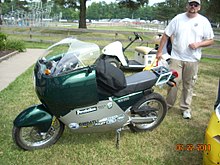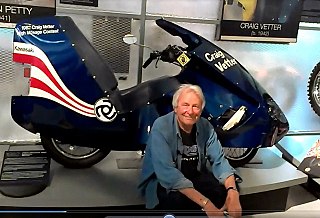| Year | Location | Winner | Fuel economy | Model | Notes |
|---|
| October 2010 | San Luis Obispo | Winner (by MPG)/Second place (by fuel cost) | 089.5 mpg‑US (2.63 L/100 km; 107.5 mpg‑imp) | Hayes Diesel motorcycle (not streamlined) | First public demonstration; bio-diesel |
| Winner (by cost of fuel consumed) | 081.4 mpg‑US (2.89 L/100 km; 97.8 mpg‑imp) | Custom Ninja 250-engined trike | |
| May 2011 | Carmel | Fred Hayes | 128 mpg‑US (1.84 L/100 km; 154 mpg‑imp) | Hayes MD670F2 Diesel motorcycle (semi faired) | |
| July 2011 | Lexington, Ohio | Max Perethian | 157 mpg‑US (1.50 L/100 km; 189 mpg‑imp) | 1989 Honda NX250 (semi faired) | 1982–1983 winner Charly Perethian designed; son rode machine
Stock bike got 86 mpg on tests before streamlining |
| November 2011 | Las Vegas to Barstow | Fred Hayes | 133.2 mpg‑US (1.766 L/100 km; 160.0 mpg‑imp) | Diesel streamliner (rider semi exposed) | Achieved second place with 143.53 mpg at prior contest |
| May 2012 | Carmel | Fred Hayes | 109.6 mpg‑US (2.146 L/100 km; 131.6 mpg‑imp) | Diesel streamliner (rider semi exposed) | |
| July 2012 | Lexington, Ohio | Fred Hayes | 143.6 mpg‑US (1.638 L/100 km; 172.5 mpg‑imp) | Diesel streamliner (rider semi exposed) | Electric motorcycle entrant had lower cost per mile but did not meet cargo requirement. |
| November 2012 | Las Vegas to Barstow | Fred Hayes | 125.92 mpg‑US (1.8680 L/100 km; 151.22 mpg‑imp) | Diesel streamliner (rider semi exposed) | |
| May 2013 | Carmel | Fred Hayes | 149.68 mpg‑US (1.5714 L/100 km; 179.76 mpg‑imp) | Diesel streamliner (rider semi exposed) | |
| July 2013 | Lexington, Ohio | Fred Hayes | 162.5 mpg‑US (1.447 L/100 km; 195.2 mpg‑imp) | Diesel streamliner (rider semi exposed) | |
| July 2014 | Lexington, Ohio | Alan Smith | 181.6 mpg‑US (1.295 L/100 km; 218.1 mpg‑imp) | Kawasaki Ninja 250 (rider semi exposed, Vetter fairing) | |
| August 2014 | Wendover to Tooele, Utah | Terry Hershner (winner, cost basis) | 116.5 watt-hours/mile | Zero Motorcycles electric customized with 20 kW-Hr of batteries, and Vetter Fairing | 80 mph speed limits. 171 mile ride This was the first time an electric motorcycle was able to complete a Vetter Challenge with the liquid fuel bikes. At all other events, the electric motorcycles lacked range to complete the course with the group and were disqualified from winning the overall lowest fuel cost per mile. Hershner $.017/mile fuel cost Hayes $.023/mile fuel cost Smith $.026/mile fuel cost |
| Alan Smith (winner, pump fuel) | 139.3 mpg‑US (1.689 L/100 km; 167.3 mpg‑imp) | Kawasaki Ninja 250 (rider semi exposed, Vetter fairing) |
| Fred Hayes (winner, alternate fuel [biodiesel]) | 164.0 mpg‑US (1.434 L/100 km; 197.0 mpg‑imp) | Diesel streamliner (rider semi exposed) |
| October 2014 | San Luis Obispo to Salinas, California | Vic Valdes (winner, pump fuel and overall) | 187.0 mpg-US | Kawasaki Ninja 250 (rider semi exposed, Vetter fairing) | $.0176 / mile (winner of pump fuel and overall winner of this event having lowest fuel cost per mile) |
| Terry Hershner (winner, electric) | 138 watt-hours/mile | Zero Motorcycles electric (with Vetter fairing - missing windshield and front turret causing higher than normal fuel usage). | $.0225 / mile |
| July 2015 | Mike Corbin Appreciation Ride, California | Alan Smith (winner pump fuel and overall) | 177.0 mpg-US | Kawasaki Ninja 250 (rider semi exposed, Vetter fairing) | $.0203 / mile |
| Terry Hershner (winner electric) | 125.4 watt-hours/mile | Zero Motorcycle Electric (without fairing) | $.0219 / mile |
| July 2015 | Lexington, Ohio | Alan Smith (winner pump fuel) | 161 mpg - US | Kawasaki Ninja 250 (rider semi exposed, Vetter Fairing) | $.0174 / mile |
| July 2016 | Lexington, Ohio | Vic Valdes (winner pump fuel and overall) | 187 mpg - US | Kawasaki Ninja 250 (rider semi exposed, Vetter fairing) | $.0110 / mile |
| Kraig Schultz (winner electric) | 92 watt-hours/mile | Custom Built Electric with Vetter Fairing from the 1980's with Airplane Canopy | $.0126 / mile |
| July 2017 | Lexington, Ohio | Vic Valdes (winner pump fuel and overall) | 236 mpg - US | Kawasaki Ninja 250 (rider semi exposed, Vetter fairing) | $.0097 / mile |
| Virginia Tech (winner electric) | 101.9 watt-hours/mile | Zero Motorcycles Electric (with Vetter fairing and custom tail built by Virginia Tech student team) | $.0134 / mile |






















